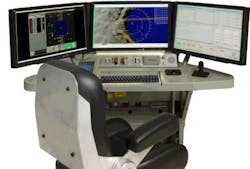Sniper-detection systems to provide perimeter security for Army forces in Afghanistan to come from Raytheon BBN
FORT BELVOIR, Va., 15 Feb. 2011. U.S. Army forces in Afghanistan needed sniper-detection systems for perimeter security in Operation Enduring Freedom operations in Afghanistan. They found their solution from Raytheon BBN Technologies in Cambridge, Mass. Raytheon BBN won a $54.3 million contract to provide 300 of its Boomerang III sniper-detection and perimeter defense systems.The Boomerang shooter-detection system uses several microphones and acoustic triangulation to locate enemy snipers and other small-arms fire to enable U.S. and allied forces to shoot back quickly and keep damage to a minimum. Awarding the contract were officials of the Army Contracting Command at Fort Belvoir, Va.Boomerang uses passive acoustic detection and computer-based signal processing to locate the shooter. When mounted on a vehicle, the system operates when the vehicle is stationary or moving. Boomerang uses a single mast-mounted, compact array of microphones to detect incoming fire -- even in urban areas from moving vehicles.
The system detects incoming supersonic small arms fire for bullet trajectories passing its microphone mast, and for shooters firing at maximum effective weapon ranges. It detects and reports incoming fire and the relative shooter position, including elevation.
The system indicates the azimuth of incoming small-arms fire by actuating a light to show the clock direction, by announcing the shooter's relative position using a recorded voice, and indicating the range and elevation on an LED display.
Boomerang prevents system false alarms caused by road bumps, door slams, wind noise, tactical radio transmissions, and extraneous noise from vehicle traffic, firecrackers, and urban activity. The system's algorithms also suppress return fire alerts by ignoring outgoing shots from around Boomerang's position.
Boomerang is currently employed by U.S. forces in Iraq and Afghanistan, and is available to U.S. military, law-enforcement agencies, municipalities, and to other approved U.S. domestic and foreign organizations.
Raytheon BBN will do the work in Cambridge, Mass., and should be finished by this August. For more information contact Raytheon BBN online at http://bbn.com, or Army Contracting Command at www.army.mil.

John Keller | Editor
John Keller is editor-in-chief of Military & Aerospace Electronics magazine, which provides extensive coverage and analysis of enabling electronic and optoelectronic technologies in military, space, and commercial aviation applications. A member of the Military & Aerospace Electronics staff since the magazine's founding in 1989, Mr. Keller took over as chief editor in 1995.

